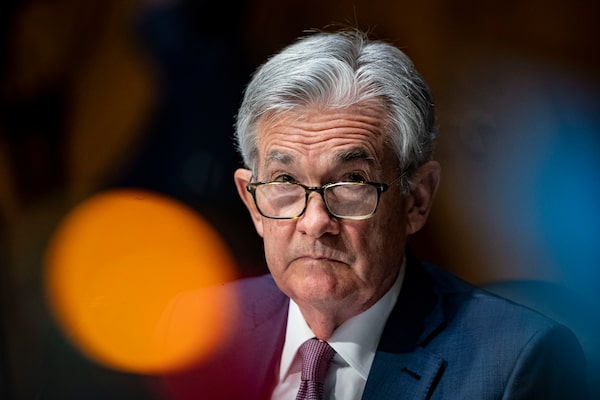
Federal Reserve Chair Jerome Powell listens during a Senate Banking Committee hearing on Capitol Hill in Washington on Dec. 1, 2020.Al Drago/The Associated Press
The U.S. Federal Reserve plans to keep its bond-buying and low-rate policies in place even as data show the economy kicking into higher gear, with policy makers predicting on Thursday that an expected increase in prices this year will fade on its own, and warning about the recent uptick in COVID-19 infections.
“Cases are moving back up here, so I would just urge that people do get vaccinated and continue socially distancing,” Fed Chair Jerome Powell, who has had his shots, said at an economic forum during virtual International Monetary Fund and World Bank meetings. “We don’t want to get another outbreak; even if it might have less economic damage and kill fewer people, it’ll slow down the recovery.”
Speaking at a separate event, St. Louis Federal Reserve Bank president James Bullard said the Fed should not even discuss changes in monetary policy until it is clear the pandemic is over, tying future Fed discussions tightly to the success of the vaccination effort.
The Fed has said it will keep buying US$120-billion in bonds a month until it sees “substantial further progress” toward meeting the central bank’s employment and inflation goals.
Mr. Bullard said he regards that as contingent on beating the coronavirus. “We have to get the pandemic behind us first,” he said. “There are still risks, and things could go in a different direction.”
The Fed has long said the virus, which touched off the sharpest downturn in decades slightly more than a year ago, will determine the course of the recovery.
Some three million Americans are getting vaccinated every day, and a majority of older Americans at highest risk of dying from COVID-19 have been fully vaccinated.
With last month’s US$1.9-trillion pandemic relief package and the Fed’s near-zero interest rates, bank officials say they expect the U.S. to see its fastest economic growth in 40 years this year.
But new variants of the virus are driving surges in caseloads in swaths of the Midwest and Northeast particularly.
Minneapolis Fed president Neel Kashkari told the Economic Club of New York in yet another virtual event on Thursday that those variants, and the school and daycare centre closings they could force, are the “biggest risks” to the U.S. recovery.
Meanwhile, much of the world has barely begun mass vaccinations, posing what policy makers said was another risk.
Fed policy makers are forecasting that a surge in spending in coming months, along with bottlenecks in supply, will push prices higher this year. But they say that’s unlikely to turn into the kind of upward spiral in prices that would constitute worrisome inflation and require the Fed to respond with rate hikes.
“We think there will be upward pressure on prices which may be passed along to consumers in the form of price increases – we think that that will be temporary,” Mr. Powell said, noting that inflation has been low for 25 years, feeding into a psychology of low inflation expectations.
And despite a government report last week showing U.S. employers added nearly a million jobs last month, there are still nearly nine million fewer employed people in the American economy than there were before the pandemic.
Mr. Powell said he would want to see “a string of months like that so we can really begin to show progress toward our goals.”
The unevenness of the recovery, too, is a serious issue, he said, with minorities, women and workers in sectors such as leisure and hospitality faring worse than others.
Fed policy makers have boosted their forecasts for growth, inflation and employment this year, but Mr. Powell noted that would not necessarily feed into any policy change.
To judge whether it was time to reduce asset purchases, Mr. Powell said, “we are not really looking at forecasts for this purpose, we are looking at actual progress” on inflation and employment.
Be smart with your money. Get the latest investing insights delivered right to your inbox three times a week, with the Globe Investor newsletter. Sign up today.